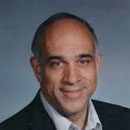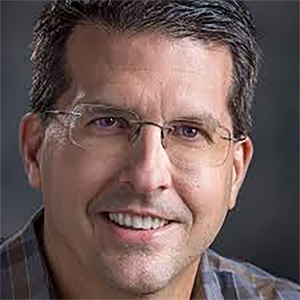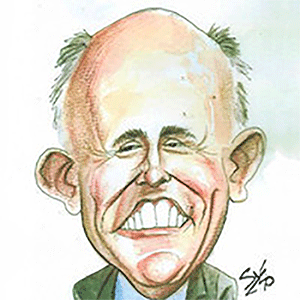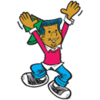John Lee Clark, a 'DeafBlind' writer, insists that bumping into things is good
Published in Books News
This story hasn’t even started and already it’s wrong.
John Lee Clark, whose “Touch the Future,” is out in paperback, would prefer not to be identified by the photograph at the top of the story. The St. Paul, Minnesota, native, who is DeafBlind (the terminology and spelling he prefers), won a National Magazine Award for an essay called “Tactile Art” and is a leader in a language movement called Protactile, which his book is the first to cover.
Rather than forcing DeafBlind people to adapt to the seeing/hearing world, Protactile is based on their ability to understand through touch; that’s one reason Clark says bumping into things is actually good. Because touching won’t help a DeafBlind person appreciate his photo, Clark prefers a description such as the one offered in “Touch the Future”: “Short hair of feline softness. Warm and smooth hands. A scent of patchouli. Flutters betray his exhilaration.”
In an email exchange with Clark, 45, I learned what he’s working on now (he and wife Adrean are pursuing doctoral studies in Montreal while their three kids remain in St. Paul) and why, as his book says, DeafBlind people want to change the world.
Q: Can you talk about what kinds of good trouble you hope the book can stir up and if you feel like there has been progress?
A: DeafBlind people, for whatever strange reason, do exist. Historically, this fact has been denied in many ways — placed in a bubble. So, expressions of our existence have not gone far in the past. But now we’re seeing extraordinary expressions of our existence, such as through the emergence of a new language.
And, to answer your question: absolutely. We have Protactile plays, art shows. We’re learning all the time what Protactile spaces are like, in terms of the built environment, where tables and chairs go, or how to run a meeting, or do a class. This fall, I’m directing a DeafBlind living history project. Research projects all over. The one I am most excited by is www.deafblindkids.org.
Q: Is it accurate to say that building a world together, with the DeafBlind and sighted/hearing communities, is a goal of the book and the Protactile movement?
A: What is supposed to happen out there is that we affect each other and are affected by each other. Everyone is supposed to shape the world in some way. Of course, various demographics do not affect others equally and are not being affected equally. Like with race — how whiteness shapes more of what goes on out there. For DeafBlind people, though, our context has been that we do not count, do not affect anything.
Protactile gave us permission to go ahead and tousle the world. What the result of that is may vary. But our stance has led many non-DeafBlind people to want to join us, to want to collaborate. So that’s great. Our working together to build a world is one result of our insisting on touching the world and affecting it.
Q: When you and your family go about your lives — eating dinner in a cluster, for instance, so you can touch each other to communicate — does it ever feel like it’s a writ-small version of the way you hope more of the world can be?
A: Yes, yes, the little things we do are the DNA of larger things, principles, concepts, policy. One example is that many of those little new habits we have maintain what we call co-presence. Many hearing and sighted people take co-presence for granted. You walk into a room, most people in that room will know you just walked in, and you know they’re there, and they know that you know they’re there. Co-presence.
So, we do all sorts of little things that help establish co-presence. It does not mean we need to be glued together, no. There are many levels to this, and one level is a kind of grid, an elastic grid. You can walk past my desk in the office, for example, if we worked in the same place, and you can use your Protactile name on my back to identify yourself. I will then know you’re there, that’s all.
Q: Given how important touch is in the movement, are there issues around consent? (Or maybe consent is implied by the language itself?)
A: For consent, you guessed correctly. For the basic situation related to consent, the language involves all four of our hands, two of mine, and your two hands, working together. Each hand has its role. I won’t go into the linguistics here, unless you want me to, but, basically, when I am speaking to you in Protactile, you would have your left hand on my right hand. Your right hand would be on my left forearm.
I would touch your arm, upper chest, etc., yes, and if we’re sitting, your leg. Those areas are part of what we call the contact space zone. But as I reach for your left shoulder — say, to establish the location of our building in Montreal — and I’m going to explain its relation to the nearest metro station, you have your left hand on top of my right hand, taking in what my right hand says or does, and you’ve got your right hand on my left hand, its primary task giving me feedback. So, you see, I’m not touching you out of the air. You’re not in a straitjacket, and I’m not playing doctor. So yes, there’s implicit, ongoing consent here, built into the whole process, the engagement. You can disengage at any time.
Q: The last paragraph of the book is sort of a call to action for hearing and sighted people to do better. I know it’s not really fair to make you do the work of teaching us how to act, but would you mind offering a few suggestions for folks who want to be good and proactive allies?
A: There’s a good distinction between helping and being helpful. Someone may jump in to “help,” but it isn’t always helpful, right? Well, one thing we do teach hearing and sighted people is how to co-navigate. It is a way to be alongside. There are things you can contribute to a process by joining it, by going along with it.
When we had sighted guides and people “responsible” for us, it was so stressful for them, because they had to try and deliver something, deliver the world, do things for us, speak for us. It was stressful for us because so little of it was what we wanted; we didn’t ask for all of that help.
But with the shift to co-navigation, everyone relaxes. We’re fumbling along, finding things out. There’s no expected product to deliver. This is quite a paradigm shift, and what you need to be is attuned. It can be a hard shift for some to make. Some may think it’s easier just to help, do a task, shove it in and be done. But that’s counterproductive, and it’s really, really worth it to listen, not be worried, and go along for the ride!
____
Touch the Future
By: John Lee Clark.
Publisher: Norton, 208 pages, $17.99.
©2024 The Minnesota Star Tribune. Visit at startribune.com. Distributed by Tribune Content Agency, LLC.













Comments